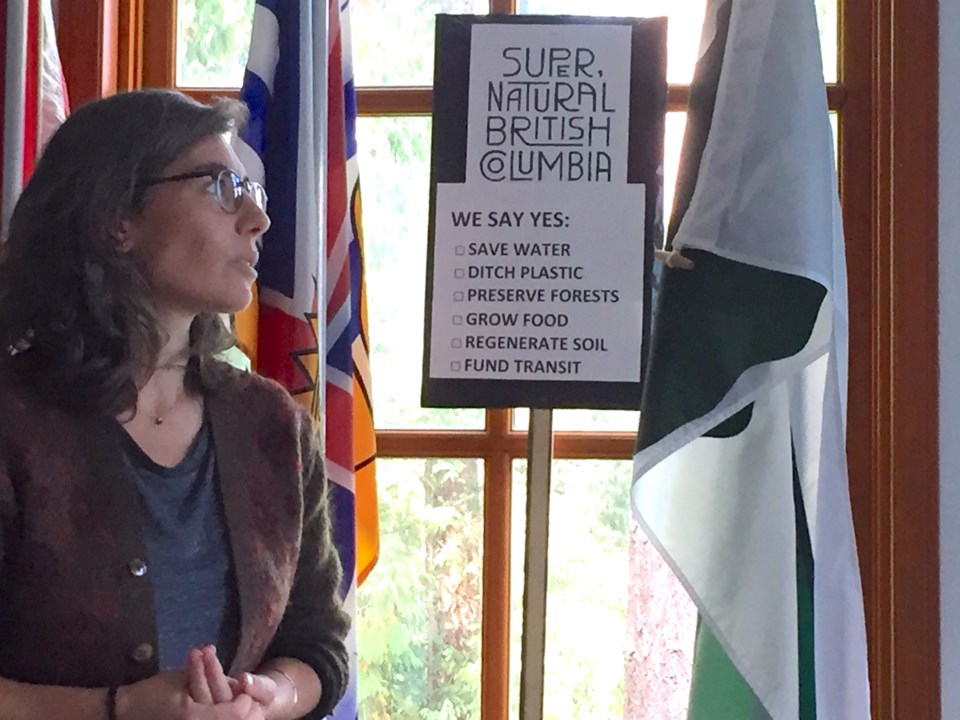Amid vibrant yellow leaves readying to fall are the brittle brown branches of dying cedar trees. On an island that’s seen three neighbourhoods on Stage 4 water restrictions this year (for a variety of environmental, social, political and economic reasons), harbingers of radical climate change are mounting.
It was in the shade of dying cedars, at a municipal “Climate Conversation,” that Bowen Island Food Sovereignty presented its two Toward a Resilient Food System for Bowen Island groundwork reports analysing the state of agriculture on the island and how we could build a resilient food system on Bowen.
The reports, an agrarian analysis and a communication and engagement groundwork report, total more than 150 pages of Bowen-focused research and analysis. They draw on research from government departments, the Islands Trust, academics, their own interviews, surveys and discussions with experts.
Back in January, agrologist Julie Sage left her job to focus on getting a food resilience project going on Bowen and, connecting with Bowen’s food sovereignty group, became project manager for this initiative. “The main driver of our work was to demonstrate that we as a community have the potential to build a more resilient food system, but also to inspire action together,” Sage told the crowd of more than 40 people on Sept. 29.
“It's only when you're faced with obstacles, stress and other environmental threats, that resilience or the lack of it emerges. Do you succumb or do you surmount?” said Sage. She said that the good news is that resilience can be planned and built, especially into a system.
“We live in a world where…our predominant food system is globalized, uniform, standardized, exploitative of natural resources,” she said. “Cheap food has a cost. Monoculture has a cost. And climate change has a cost.”
“We essentially need to move towards something that is more respectful. And we need to transition towards a food system that is more regenerative, that is more localized, that is prioritizing people's health [and] ecological health.”
“Food tends to be taken for granted, and it shouldn't be.”
The group identified five indicators of food resilience, which Sage stressed is not a final or exhaustive list of indicators: food sovereignty, natural resource stewardship, arable land use management, green waste management and economic viability. Sage and the team assess the state of each over the course of the reports, finding that while Bowen is currently highly dependent on the mainland, this hasn’t always been the case, and needn’t necessarily be in the future.
The agricultural analysis report notes that the B.C. Ministry of Agriculture found in 2016 that 27 hectares on Bowen were being actively farmed, a 26 per cent decrease from five years earlier. The Agricultural Reserve Land on Bowen is between 172 and 182 hectares, though not all of this is available or suitable for farming.
Through their research, the group found among the obstacles to more farming on Bowen were lack of time, space and knowledge; limitations due to health, age, physical ability or lack of financial resources and the poor economic viability of farming on Bowen. BIFS found that all of the food producers it talked to worked other jobs. When it came to meat production, meat slaughter and processing is prohibited on Bowen, meaning raising livestock on-island is an expensive endeavour.
“Several interviewees confirmed that they would have more animals if the regulations around production and processing were eased,” said the communication and engagement report.
The potential for water shortages and need to maintain forest cover, especially at the higher altitudes (trees and vegetation trap water rather than letting it fall into the sea) were themes throughout both reports.
The communications report surveys agrarian evolution over decades of living memory. From the '20s when a young Marion Moore of Collins Farm would provide milk for the Union Steamship Cottagers, to the '50s when Alastair Johnstone remembers everyone had their own gardens and would grow what they could, to the rural-semi-rural transition of the '70s and '80s. It demonstrates both a history of and suggests a potential for increased agriculture on the island.
Among the suggestions in the communication and engagement report for food resilience on Bowen were convening a temporary task force of natural resource professionals to advise the municipality; encouraging rainwater capture and water conservation; ensuring development considers impact on surrounding ecosystems; developing an invasive species program to get rid of skunks, rats, raccoons and other invasive species and examining pesticide restrictions.
The complex issue of composting on-island has its own thorough set of recommendations, among them, monitoring the trial of a Johnson-Su bioreactor built at the Grafton Community Garden.
“It used to be that when I saw something like this…I didn't want to see it. I didn't want anybody to talk to me about it,” said Jackie Bradley (of BIFS) at the talk. “One day, I decided that I actually had to face those fears. And that changed my life.
“I definitely saw the possibility of a scary future. But, and this is a rather big ‘but’, I also saw…many wonderful things and incredible people all around the world that were dedicating their lives to solving the problems of climate change.
“This made me feel excited, empowered, and like I could actually do something to help here.”
The reports are available on the municipal website at bowenislandmunicipality.ca/climate-action-program.



